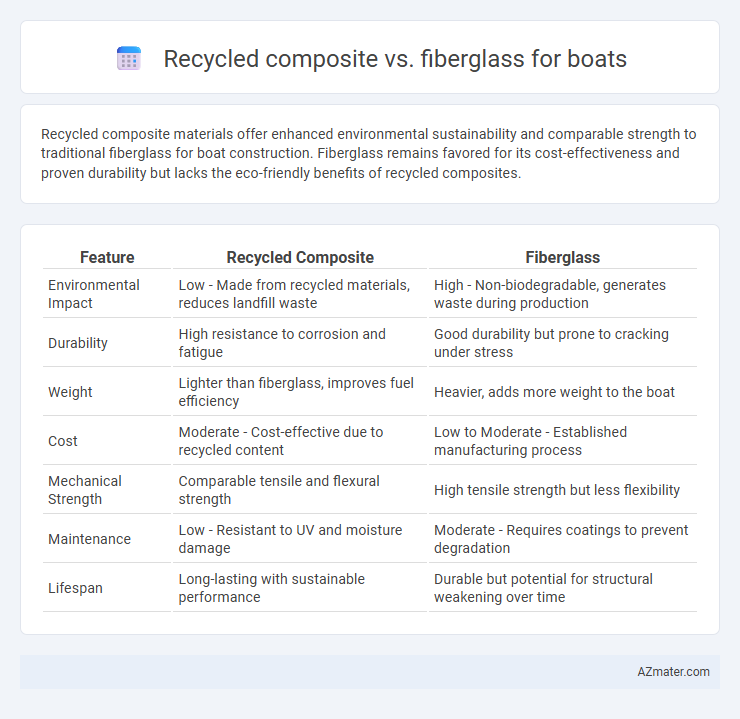Recycled composite materials offer enhanced environmental sustainability and comparable strength to traditional fiberglass for boat construction. Fiberglass remains favored for its cost-effectiveness and proven durability but lacks the eco-friendly benefits of recycled composites.
Table of Comparison
| Feature | Recycled Composite | Fiberglass |
|---|---|---|
| Environmental Impact | Low - Made from recycled materials, reduces landfill waste | High - Non-biodegradable, generates waste during production |
| Durability | High resistance to corrosion and fatigue | Good durability but prone to cracking under stress |
| Weight | Lighter than fiberglass, improves fuel efficiency | Heavier, adds more weight to the boat |
| Cost | Moderate - Cost-effective due to recycled content | Low to Moderate - Established manufacturing process |
| Mechanical Strength | Comparable tensile and flexural strength | High tensile strength but less flexibility |
| Maintenance | Low - Resistant to UV and moisture damage | Moderate - Requires coatings to prevent degradation |
| Lifespan | Long-lasting with sustainable performance | Durable but potential for structural weakening over time |
Introduction: The Need for Sustainable Boat Materials
Recycled composite materials offer a sustainable alternative to traditional fiberglass in boat construction, significantly reducing environmental impact through the reuse of waste plastics and fibers. Fiberglass, while durable and widely used, relies heavily on non-renewable resources and generates considerable waste during manufacturing and disposal. Adopting recycled composites promotes eco-friendly practices by lowering carbon emissions and enhancing material recyclability within the marine industry.
What Are Recycled Composites?
Recycled composites are materials made by reprocessing used composite waste, such as fiberglass, carbon fiber, or resin, to create new, sustainable products for marine applications. These composites typically blend reclaimed fibers with virgin or bio-based resins to maintain strength and durability comparable to traditional fiberglass. Utilizing recycled composites in boat construction reduces landfill waste, lowers environmental impact, and supports circular economy initiatives in the boating industry.
Understanding Traditional Fiberglass Boats
Traditional fiberglass boats are constructed using glass fibers embedded in a resin matrix, providing durability, strength, and resistance to water damage. Unlike recycled composite materials, fiberglass offers a proven track record with well-established manufacturing processes and repair techniques, making it a popular choice in the marine industry. However, fiberglass production involves energy-intensive methods and non-biodegradable waste, prompting increased interest in sustainable alternatives like recycled composites.
Strength and Durability Comparison
Recycled composite materials for boats offer enhanced strength and durability due to their high resistance to corrosion, impact, and fatigue compared to traditional fiberglass. Fiberglass, while strong and relatively lightweight, tends to suffer from micro-cracking and osmotic blistering over time, reducing its long-term durability. The incorporation of recycled composites often results in improved structural integrity and longer lifespan, making them a superior choice for marine applications where strength and durability are critical.
Environmental Impact: Recycled Composite vs Fiberglass
Recycled composite materials significantly reduce environmental impact compared to traditional fiberglass by utilizing waste products and lowering landfill contributions. Fiberglass production involves high energy consumption and emits toxic chemicals, contributing to pollution and resource depletion. Choosing recycled composites promotes sustainability through reduced carbon footprints and supports circular economy practices in boat manufacturing.
Weight and Performance Considerations
Recycled composite materials for boats typically offer a lighter weight compared to traditional fiberglass, enhancing fuel efficiency and maneuverability. The superior strength-to-weight ratio of recycled composites improves overall performance by providing increased stiffness and durability without adding significant mass. Fiberglass, while durable and cost-effective, generally results in heavier vessels that may compromise acceleration and handling characteristics.
Cost Analysis and Economic Feasibility
Recycled composite materials for boats typically offer lower raw material costs compared to traditional fiberglass, driven by the use of reclaimed fibers and resins, which reduces production expenses. The manufacturing process of recycled composites often requires less energy and waste management, enhancing economic feasibility by minimizing operational costs. Fiberglass, while widely available and established, tends to incur higher long-term maintenance and disposal costs, making recycled composites a more cost-effective and sustainable option in the marine industry.
Maintenance and Longevity
Recycled composite materials offer enhanced resistance to corrosion and UV damage compared to traditional fiberglass, significantly reducing maintenance requirements over time. Fiberglass boats may require regular gelcoat repairs and more frequent inspections to prevent water intrusion and structural degradation. The longevity of recycled composite boats can exceed that of fiberglass, as their durable, eco-friendly makeup resists wear and environmental damage more effectively.
Design Flexibility and Aesthetic Options
Recycled composite materials offer superior design flexibility compared to fiberglass, allowing boat manufacturers to create complex shapes and customized features with greater ease due to their moldability and adaptability. These composites provide a wide range of aesthetic options, including varied textures, colors, and finishes that enhance the visual appeal while maintaining sustainability credentials. Fiberglass, while durable and widely used, has more limitations in design complexity and customization, often resulting in more uniform and less distinctive appearances.
Future Trends in Boat Building Materials
Recycled composite materials are emerging as a sustainable alternative to traditional fiberglass in boat building, offering enhanced environmental benefits through reduced waste and lower carbon footprints. Innovations in bio-based resins and recycled fibers are driving improved durability and performance in recycled composites, positioning them as a key future trend in marine construction. These advancements align with industry goals for eco-friendly manufacturing, lightweight structures, and increased recyclability, signaling a shift toward greener boat building practices.

Infographic: Recycled composite vs Fiberglass for Boat
 azmater.com
azmater.com